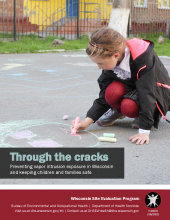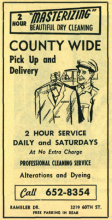Air: Vapor Intrusion
What is vapor intrusion?
Vapors from past chemical spills can affect the quality of air you breathe, even indoors. That’s because some of the contamination from the spill can leak into the ground and stay there for many years.
Some of these chemicals, such as volatile organic compounds (VOCs), can turn into vapor, moving through the soil and along underground utility lines to the foundations of nearby buildings.
The vapor can enter buildings through cracks in the foundation or along utility lines.
This is called vapor intrusion.
The process of vapor intrusion is similar to how radon gas enters homes.
The difference is that radon gas occurs naturally in the soil; vapor intrusion occurs because of chemical contamination.
Vapor intrusion can make you sick
The health effects from vapor intrusion depend on several factors, including:
- The concentration of your exposure.
- The length of time you’re exposed.
- The specific chemical or chemicals in the vapor.
You also can have different reactions depending on:
- Your genes.
- Your personal health.
- Your previous exposure to other chemicals.
Short-term exposure
Short-term exposure to high levels of VOC vapor in air can cause symptoms including:
- Drowsiness.
- Eye and respiratory irritation.
- Headaches.
- Nausea.
- Slowed reflexes.
These symptoms are usually temporary and go away when you get fresh air.
If you smell VOC odors indoors, you should assume you’re being exposed to toxic chemicals and increase ventilation in the area. You also should avoid that part of the building until the odor goes away.
Long-term exposure
Long-term exposure to low levels of VOC vapor in air can also cause problems, including an increased cancer risk. This is especially dangerous when people don’t realize they’re breathing in toxic chemicals, which can happen when a chemical is odorless.
Exposure during pregnancy
Exposure to a VOC called trichloroethylene, or TCE—a human-made chemical with a sweet smell—can harm a developing fetus, including raising the risk of heart defects.
This can happen with low levels of the chemical and cause harm early in pregnancy, sometimes before someone even knows they’re pregnant. That’s why people who are pregnant or planning to become pregnant should avoid exposure.
Investigating contamination
The most common cases of vapor intrusion involve odorless solvents from commercial and industrial properties. In many of these cases, chemical spills aren’t discovered right away. Once they are, the contamination has generally had time to spread away from the area where it was spilled and into surrounding soil and groundwater.
If you live or work near a site with a reported VOC contamination, assume that an investigation is underway for potential vapor intrusion. People responsible for investigating and cleaning up the contamination may reach out to you to get your cooperation and consent before testing or sampling your property. You can ask the investigators any questions you have about the inspection process. They’re responsible for the contamination cleanup and are required to investigate how far the contamination spreads, including neighboring properties.
You can review an online database of sites with environmental contamination in Wisconsin. Go to the Department of Natural Resources’ (DNR) Remediation and Redevelopment page and select the “Launch” button for “BRRTS on the Web.”
Taking air samples
In some cases, investigators can rule out the potential for vapor intrusion by collecting soil gas or groundwater samples near the contamination site. In other cases, they need to sample closer to neighboring properties to rule out risk. Investigators may also take samples from beneath a building’s foundation, called sub-slab sampling. They often will take indoor air samples at the same time to determine if chemical vapors are getting in through cracks in the floor, piping, or other entryways.
Vapor mitigation systems
If vapor intrusion is present in your home or business, the most common solution is to install a vapor mitigation system, which looks and operates similar to a radon mitigation system.
These systems prevent chemical vapors from entering the home or business. They’re also designed to prevent radon gas from entering—an added benefit.
In addition to cleanup, contamination investigators are responsible for paying for the installment of the vapor mitigation system.
Because some contamination persists for long periods of time, mitigation systems need to stay in place for many years.
State rules say investigators can turn these mitigation systems over to property owners to run once DNR calls the investigation and cleanup complete, even if some contamination remains.
Property owners must operate these systems until DNR says it’s no longer required.
Find fact sheets on this topic and other resources for property owners on DNR’s vapor intrusion webpage.
VOCs in household products
Household products can contain VOCs. For this reason, they’re more likely to be the source of indoor air quality problems than vapor intrusion from a contamination site.
These household products contain VOCs:
- Aerosol sprays
- Air fresheners
- Cigarette smoke
- Dry-cleaned clothing
- Hobby supplies (glues and solvents)
- Moth balls
- New carpeting or furniture
- Paint strippers and thinners
- Paints
- Stored fuels
Improving air quality in your home
Here are some tips to improve your indoor air quality:
- Air out your home. Fresh air can help you prevent both the buildup of chemicals in the air and mold growth.
- Contact your local health department if you smell a chemical odor that doesn’t seem to be coming from an indoor source. Contact your local fire department to determine if a fire hazard exists if you smell very strong odors.
- Don’t buy more chemicals than you need at one time.
- Fix all leaks promptly and control moisture, which encourages mold growth. Have all major appliances and fireplaces checked each year by a professional.
- Store unused chemicals in appropriate containers in a well-ventilated location.
- Test your home for radon.
Visit our Air Quality Issues webpage and Breathe Easily fact sheet, P-02166 for more ideas on how to improve your indoor air quality.
Resources for environmental professionals
- DNR’s vapor intrusion resources webpage
- The Environmental Protection Agency’s Office of Solid Waste and Emergency Response’s Technical Guide for Assessing and Mitigating the Vapor Intrusion Pathway from Subsurface Vapor Sources to Indoor Air (PDF)
“Through the Cracks” toolkit and dry-cleaner inventory
The Wisconsin Department of Health Services (DHS) produced Through the Cracks: Preventing Vapor Intrusion Exposure in Wisconsin and Keeping Children and Families Safe, P-03070 (PDF).
This toolkit introduces public health officials to the risks posed by former dry-cleaning buildings that have been contaminated with harmful chemicals.
The toolkit aims to help prevent exposures to people living or working in these buildings now and in the future.
Contaminations in these buildings stemmed from improper disposal practices by dry-cleaning businesses throughout much of the 20th century. At the time, dry cleaners often used cleaning solvents that contained chemicals known as chlorinated volatile organic compounds, or CVOCs. Inadequately disposing of CVOCs often caused them to spill into the environment. CVOCs take a long time to break down, meaning the chemicals can last for decades in the ground below and next to the building. Over time, they can turn into vapor and lead to vapor intrusion in the building.
To document the locations of these former dry-cleaning sites, the toolkit suggests public health officials use old phone books to find and inventory past businesses, putting them into an electronic spreadsheet. Use this inventory template (Excel), which contains detailed instructions and examples. Officials can then prioritize the sites based on special criteria to determine the likelihood that contamination remains in or near the building.
Old phone books are the preferred way to find former dry-cleaning businesses to guide your search. Phone books can help because they’re comprehensive, use relatively consistent categorization, and contain ads, like the one to the right, that provide clues about business activities. For example, dry cleaners that advertised service in four hours or less are more likely to have used CVOC chemicals on-site.
The toolkit outlines this process, as well as actions public health officials can take to prevent potential exposure in identified sites. For questions or help with this process, email dhsenvhealth@dhs.wisconsin.gov.



